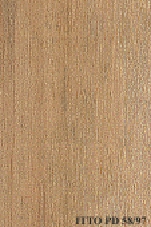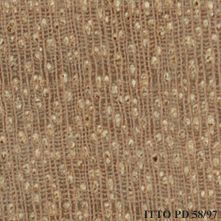
JEQUITIBA (Cariniana integrifolia)
Trade Name
Jequitiba
Scientific Name
Cariniana integrifolia Ducke
Family
LECYTHIDACEAE
Common Names
Jequitiba (Brazil)
Description Of The Tree
Botanical Description
Cariniana trees are often about 30 to 40 m in height, with a trunk diameter of about 100 to 120 cm. It has a clean bole up to two thirds of the total length.
Natural Habitat
Confined to non-flooded forest of central Amazonia, near Manaus, the species is under threat from increasing land settlement and fires.
Natural Distribution
This species is reported in the vicinity of Manaus, Brazil.
Wood Identification
Anatomic Description Of Wood
Vessels per mm2 less than 6 (rare). Wood diffuse porous. Vessels solitary and in short radial multiples. Tyloses common. Tangential diameter of vessel lumina 200 micras or more (large). Vessel-ray pits similar to intervessel pits in size and shape. Simple perfo Axial parenchyma apparent with the naked eye. Axial parenchyma in marginal or in seemingly marginal bands. Axial parenchyma in continuous tangential lines (included in reticulate and scalariform). Axial parenchyma bands over 4 per mm. 4 to 10 rays per mm (medium). Rays 1 to 4 seriate. Homogeneous rays and/or sub-homogeneous rays (all ray cells procumbent). Fibers with simple to minutely bordered pits.
-
 Wood Macro Photo Radial Plane
Wood Macro Photo Radial Plane
-
 Wood Micro Photo Of Transversal Section
Wood Micro Photo Of Transversal Section
Availability
Cites Status
Unrestricted
General Wood Description
Odor
No odor or taste are reported for this species.
Color
The sapwood is not clearly demarcated form the reddish or purplish-brown heartwood.
COLOR INDEX (1=Black, 7=Light yellow,white)
4
Grain
The grain is straight to interlocked.
Texture
The texture is medium.
Luster
The wood is commonly of medium luster.
Natural Durability
The heartwood is reported to be durable. It is resistant to attack by dry-wood termites.
Natural durability index (1= Very high durability, 7=Vey low durability)
3
Silica Content
Silica Content: Some Cariniana timbers are reported to have high silica content. Silica contents over 0.05% of dry weight are generally believed to affect the machining properties of wood. Silica Value: 0.05
Resistance To Impregnation
The heartwood responds very poorly to preservative treatment, but the sapwood is permeable.
Wood Physical Properties
Basic Density or Specific Gravity (O.D. weight/vol. green) (g/cm³)
0.53
Air-dry Density (Weight and volume at 12%MC) (g/cm³)
0.58
Total shrinkage Tangential (Saturated to 0%MC) (%)
5.0
Total shrinkage Radial (Saturated to 0%MC) (%)
3.0
Drying Defects
Ease of Drying: Air seasoning is reported to be moderate. Drying Defects: Risk of warping is reported.
Recommended Dry Kiln Schedule
US-T3-D2; UK-D
Dimensional stability ratio (Total Tangential Shrinkage %/Total Radial Shrinkage %)
1.7
Wood Chemical Properties
Wood Mechanical Properties
Compression parallel to fiber 12%MC (kgf/cm²)
479
Shear strength radial 12%MC (kgf/cm²)
143
Janka hardness (side) 12%MC (kgf)
463
Workability
Sawing
Cariniana timber is easy to saw, but it may blunt the band saws.
Rotary Veneer Cutting
This wood is interesting for peeling.
Sliced Veneer
This wood is interesting for peeling.
Blunting Effect
It is reported to have a moderate blunting effect on cutting edges because of silica.
Machining
Most woodworking qualities of Cariniana are rated as satisfactory.
Planing
Planing operations are rather easy, but dull cutting edges may cause grain tearing.
Turning
30
Nailing
The wood nails satisfactorily but pre-boring is recommended.
Gluing
This wood glues well.
Finishing
It gives a smooth finish.
Staining
The material takes stains well.
Polishing
The wood finishes well.
REFERENCED USES
End Uses Summary
HOUSING GENERAL, flooring, fittings, FURNITURE AND CABINETS, PLYWOOD AND VENEER, faces, cores, TURNING, OTHER AND MUSICAL INSTRUMENTS, moldings
General Housing
- 10 - Silica in Timbers
Flooring
- 14 - Handbook of Hardwoods
Fittings
- 19 - Silica in Timbers
Furniture Cabinets
- 21 - Tropical timbers of the world. Part III-Southeast Asian and Oceanian Species.
Panels, Veneers
- 25 - Directory of Timber Trade Malaysia
Faces
- 26 - Annual Review and Assessment of the World Timber Situation 1998-ITTO
Cores
- 27 - Embassy of Brazil in Japan
Turning
- 30 - Embassy of Honduras in Japan
Molding
- 79 - Padronização da Nomenclatura Comercial Brasileira das Madeiras Tropicais Amazônicas, Sugestão
Please Provide Information To View Producer Information